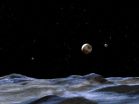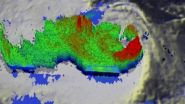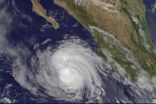(Press-News.org) If the icy surface of Pluto's giant moon Charon is cracked, analysis of the fractures could reveal if its interior was warm, perhaps warm enough to have maintained a subterranean ocean of liquid water, according to a new NASA-funded study.
Pluto is an extremely distant world, orbiting the sun more than 29 times farther than Earth. With a surface temperature estimated to be about 380 degrees below zero Fahrenheit (around minus 229 degrees Celsius), the environment at Pluto is far too cold to allow liquid water on its surface. Pluto's moons are in the same frigid environment.
Pluto's remoteness and small size make it difficult to observe, but in July of 2015, NASA's New Horizons spacecraft will be the first to visit Pluto and Charon, and will provide the most detailed observations to date.
"Our model predicts different fracture patterns on the surface of Charon depending on the thickness of its surface ice, the structure of the moon's interior and how easily it deforms, and how its orbit evolved," said Alyssa Rhoden of NASA's Goddard Space Flight Center in Greenbelt, Maryland. "By comparing the actual New Horizons observations of Charon to the various predictions, we can see what fits best and discover if Charon could have had a subsurface ocean in its past, driven by high eccentricity." Rhoden is lead author of a paper on this research now available online in the journal Icarus.
Some moons around the gas giant planets in the outer solar system have cracked surfaces with evidence for ocean interiors – Jupiter's moon Europa and Saturn's moon Enceladus are two examples.
As Europa and Enceladus move in their orbits, a gravitational tug-of-war between their respective parent planets and neighboring moons keeps their orbits from becoming circular. Instead, these moons have eccentric (slightly oval-shaped) orbits, which raise daily tides that flex the interior and stress the surface. It is thought that tidal heating has extended the lifetimes of subsurface oceans on Europa and Enceladus by keeping their interiors warm.
In Charon's case, this study finds that a past high eccentricity could have generated large tides, causing friction and surface fractures. The moon is unusually massive compared to its planet, about one-eighth of Pluto's mass, a solar system record. It is thought to have formed much closer to Pluto, after a giant impact ejected material off the planet's surface. The material went into orbit around Pluto and coalesced under its own gravity to form Charon and several smaller moons.
Initially, there would have been strong tides on both worlds as gravity between Pluto and Charon caused their surfaces to bulge toward each other, generating friction in their interiors. This friction would have also caused the tides to slightly lag behind their orbital positions. The lag would act like a brake on Pluto, causing its rotation to slow while transferring that rotational energy to Charon, making it speed up and move farther away from Pluto.
"Depending on exactly how Charon's orbit evolved, particularly if it went through a high-eccentricity phase, there may have been enough heat from tidal deformation to maintain liquid water beneath the surface of Charon for some time," said Rhoden. "Using plausible interior structure models that include an ocean, we found it wouldn't have taken much eccentricity (less than 0.01) to generate surface fractures like we are seeing on Europa."
"Since it's so easy to get fractures, if we get to Charon and there are none, it puts a very strong constraint on how high the eccentricity could have been and how warm the interior ever could have been," adds Rhoden. "This research gives us a head start on the New Horizons arrival – what should we look for and what can we learn from it. We're going to Pluto and Pluto is fascinating, but Charon is also going to be fascinating."
Based on observations from telescopes, Charon's orbit is now in a stable end state: a circular orbit with the rotation of both Pluto and Charon slowed to the point where they always show the same side to each other. Its current orbit is not expected to generate significant tides, so any ancient underground ocean may be frozen by now, according to Rhoden.
Since liquid water is a necessary ingredient for known forms of life, the oceans of Europa and Enceladus are considered to be places where extraterrestrial life might be found. However, life also requires a useable energy source and an ample supply of many key elements, such as carbon, nitrogen, and phosphorus. It is unknown if those oceans harbor these additional ingredients, or if they have existed long enough for life to form. The same questions would apply to any ancient ocean that may have existed beneath the icy crust of Charon.
INFORMATION:
This research was funded by the NASA Postdoctoral Program at the NASA Goddard Space Flight Center, administered by Oak Ridge Associated Universities, and NASA Headquarters through the Science Innovation Fund.
Cracks in Pluto's moon could indicate it once had an underground ocean
2014-06-13
ELSE PRESS RELEASES FROM THIS DATE:
UH's Thomas Colbert addressing Galveston Bay's Challenges at Rotterdam Biennale
2014-06-13
Coastal communities are often relaxing locales with lush natural attributes. At the same time, they face many challenges from both natural and manmade elements.
Thomas Colbert, professor at the University of Houston's Gerald D. Hines College of Architecture, dedicates his research to discovering ways to protect coastlines and delta regions from severe weather threats and other dangers. This week, he joins a roster of international scholars, designers and architects at the 2014 International Architecture Biennale Rotterdam (IABR) in the Netherlands.
Colbert is among ...
NIH scientists take totally tubular journey through brain cells
2014-06-13
VIDEO:
Researchers watched TAT proteins (green) journey into microtubules (red). TAT proteins are known to label the insides of the tubes. They observed that TAT can move quickly, back and...
Click here for more information.
In a new study, scientists at the National Institutes of Health took a molecular-level journey into microtubules, the hollow cylinders inside brain cells that act as skeletons and internal highways. They watched how a protein called tubulin acetyltransferase ...
NASA experiments recreate aromatic flavors of Titan
2014-06-13
NASA scientists have created a new recipe that captures key flavors of the brownish-orange atmosphere around Saturn's largest moon, Titan.
The recipe is used for lab experiments designed to simulate Titan's chemistry. With this approach, the team was able to classify a previously unidentified material discovered by NASA's Cassini spacecraft in the moon's smoggy haze.
"Now we can say that this material has a strong aromatic character, which helps us understand more about the complex mixture of molecules that makes up Titan's haze," said Melissa Trainer, a planetary scientist ...
'Exquisitely engineered' human vision featured in Optical Engineering
2014-06-13
BELLINGHAM, Washington, USA — A new special section on Human Vision in the current issue of Optical Engineering showcases optics and optical engineering research into new techniques and approaches for the study of human vision and the design of novel imaging systems. Put into practice, these new approaches enable applications such as earlier diagnosis of disease, improved treatment monitoring, and more accurate guidance for treatment and surgery. The journal is published by SPIE, the international society for optics and photonics.
The special section includes 11 papers ...
NASA sees Tropical Storm Nanauk's soaking swan song
2014-06-13
VIDEO:
This TRMM satellite flyby animation shows that Tropical Storm Nanauk contained powerful towering thunderstorms that were reaching heights of up to 16.8 km (10.4 miles) on June 11, 2014....
Click here for more information.
Tropical Storm Nanauk was dissipating in the Arabian Sea on Friday, June 13 as it ran into increasing vertical wind shear, dry air moving into the tropical cyclone and cooler sea surface temperatures. NASA's TRMM satellite observed the soaking rains the ...
NASA sees Hurricane Cristina making a reverse in strength
2014-06-13
Hurricane Cristina intensified rapidly on June 12 and infrared satellite data showed cloud top temperatures became extremely cold as thunderstorms towered to the top of the troposphere. One day later, Cristina was weakening quickly and infrared data showed cloud top temperatures were warming as the cloud tops dropped.
Infrared data basically reads a cloud top's temperature. When NASA's Aqua satellite passed over Hurricane Cristina early on June 12, cloud top temperatures exceeded -80C (-112F). Today, June 13, infrared data showed cloud top temperatures had warmed to near ...
Nurses play critical role in responding to global resurgence of pertussis
2014-06-13
(June 13, 2014)- Concerted effort is needed to reverse the ongoing rise in pertussis cases and deaths, especially among children and young people, according to the article by Emily Peake, APRN, MSN, FNP-C, CLC, and Lisa K. McGuire, MSN, MBA-HCM, RN. "This effort begins with nurses and nurse practitioners and other primary care providers who educate patients and the public," they write. "The battle of pertussis is winnable through education, awareness, and vaccination."
In US and Abroad, Rising Rates of Pertussis Infection and Death
Caused by infection with Bordetella ...
UH research focuses on how food marketing creates a false sense of health
2014-06-13
Health-related buzzwords, such as "antioxidant," "gluten-free" and "whole grain," lull consumers into thinking packaged food products labeled with those words are healthier than they actually are, according to a new research study conducted by scholars at the University of Houston (UH).
That "false sense of health," as well as a failure to understand the information presented in nutrition facts panels on packaged food, may be contributing to the obesity epidemic in the United States, said Temple Northup, an assistant professor at the Jack J. Valenti School of Communication ...
Who's using your data?
2014-06-13
By now, most people feel comfortable conducting financial transactions on the Web. The cryptographic schemes that protect online banking and credit card purchases have proven their reliability over decades.
As more of our data moves online, a more pressing concern may be its inadvertent misuse by people authorized to access it. Every month seems to bring another story of private information accidentally leaked by governmental agencies or vendors of digital products or services.
At the same time, tighter restrictions on access could undermine the whole point of sharing ...
Moffitt study shows utilizing genetic health care professional reduces unnecessary testing
2014-06-13
TAMPA, Fla. (June 13, 2014) – A new Moffitt Cancer Center study published Thursday in Genetics in Medicine shows that counseling from a genetic health care provider before genetic testing educates patients and may help reduce unnecessary procedures.
Up to 10 percent of cancers are inherited, meaning a person was born with an abnormal gene that increases their risk for cancer. "Pre-test genetic counseling in which a health care provider takes a thorough family history and discusses the potential risks and benefits of genetic testing is standard of care as recommended ...







